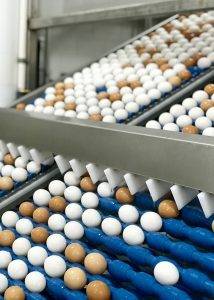 Guest blog post by Anita McVey of Picnic Life Foodie
Guest blog post by Anita McVey of Picnic Life Foodie
One of my most vivid memories from childhood was visiting my grandma’s farm to see the baby chickens. We would walk out to the coop, and she would carefully open the door to a floor full of bright yellow, peeping fluff-balls. I learned quickly to shuffle my feet instead of trying to step through them and with each movement forward the chicks would scatter away, just out of my reach, creating an empty triangle in front of me.
When you grow up with, or have access to, experiences that show how food gets to the table, your appreciation for that food is elevated. The Iowa Food and Family Project (IFFP) is one organization trying provide such experiences to consumers who want to learn more about Iowa agriculture.
The IFFP recently sponsored a “Food U” day trip in honor of May being National Beef Month and National Egg Month. We toured an Iowa cattle farm, as well as the Rose Acre Farms egg facility in Guthrie Center. This tour gave me a new respect for each carton of eggs I bring home from the grocery store.
With 17 facilities in eight states, Rose Acre Farms is the second largest egg producer in the United States. From a small farm in Indiana, this now high-tech and innovative producer has managed to maintain the ethics and values that established this family-owned company in the beginning.
 Once we entered the property, our first action was to drive the bus through the on-site, sanitizing car wash that was installed a few years ago as another way to protect the animals from disease and the eggs from contamination.
Once we entered the property, our first action was to drive the bus through the on-site, sanitizing car wash that was installed a few years ago as another way to protect the animals from disease and the eggs from contamination.
Food safety is serious business. We wore lab coats and protective coverings on our shoes and hair, walked through sanitizing solutions between each area of the facility, removed our jewelry, used ear plugs and signed waivers regarding our health and lack of exposure to other animal facilities.
As the eggs travel through the facility, they are sorted for different purposes. Broken shells are crushed for fertilizer. Broken eggs are processed and purified for pet food. Nonstandard eggs are cracked; the yolk and whites are separated for specialty products like liquid eggs, dried egg powder and even egg white protein powder. The eggs that pass all the inspections are sorted and packaged for shipping.
This company has grown is size and scope, but Rose Acre Farms continues to show respect and gratitude to the communities in which they operate. They regularly donate to local causes (e.g. fundraisers), social groups (e.g. 4-H) and community events. Just imagine how popular the breakfast events are around these towns.
All the hard work made me hungry– and all I did was watch and learn! Take a moment the next time you crack an egg (or six) to be grateful for the hands and the hens that provided them in such a convenient and safe way.
 Today I’m sharing with you a recipe for Shakshuka. I made this recipe for my family during Memorial Day weekend, and it was a hit! While I realize this isn’t traditional Midwestern fare, I enjoy trying new things. Versions of this Middle Eastern/North African breakfast food have been filling my social media feed and are being featured on many cooking shows recently, so I decided to try my hand at making it. Serve with pita or naan bread – found in most Fareway and Hy-Vee stores – as a vehicle to get a little of everything in one bite! Served family-style, Shakshuka just might be the ultimate “eggs-for-dinner” recipe.
Today I’m sharing with you a recipe for Shakshuka. I made this recipe for my family during Memorial Day weekend, and it was a hit! While I realize this isn’t traditional Midwestern fare, I enjoy trying new things. Versions of this Middle Eastern/North African breakfast food have been filling my social media feed and are being featured on many cooking shows recently, so I decided to try my hand at making it. Serve with pita or naan bread – found in most Fareway and Hy-Vee stores – as a vehicle to get a little of everything in one bite! Served family-style, Shakshuka just might be the ultimate “eggs-for-dinner” recipe.
Shakshuka
Ingredients
- 2 tablespoons olive oil
- 1 medium onion, diced
- 1 green or red bell pepper, diced
- 3 cloves garlic, minced
- 1 teaspoon paprika
- 1 teaspoon cumin
- 1 teaspoon chili powder
- 1/2 teaspoon crushed red pepper flakes
- 1, 28-ounce can stewed or diced tomatoes
- 1/4 cup sliced olives (optional)
- 6 large eggs
- Salt and pepper
- Feta or goat cheese (optional)
- Fresh cilantro or parsley (or both)
- Fresh lemon wedges (optional)
- Warm pita, naan or other favorite bread
Directions
- In a large skillet, sauté onions and peppers in olive oil over medium heat for about 6 to 8 minutes or until soft. Add garlic and spices; sauté for 1 to 2 minutes. Add tomatoes and simmer for 15 to 20 minutes or until sauce reached a thick consistency. (If using canned whole tomatoes, break into bite-sized pieces as they simmer.) Taste the sauce and add salt and pepper as needed.
- While the sauce is cooking, crack each egg into its own small bowl. When sauce is thick and hot, use a large spoon or ladle to make indents, or “wells,” in the sauce. Pour one egg in each well. Sprinkle with salt and pepper. Cover the pan and continue cooking for 5 to 8 minutes or until the eggs are cooked as desired (less time for soft egg yolks and more for firm yolks).
- Remove from heat and serve with fresh herbs, cheese, lemon wedges and warm bread.
